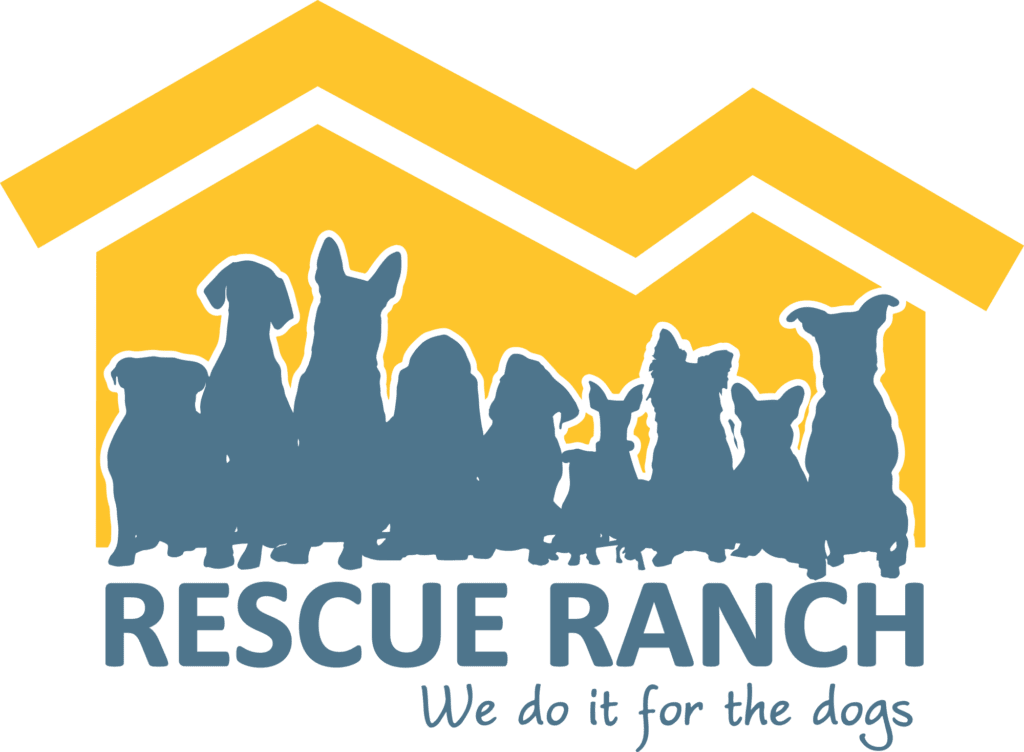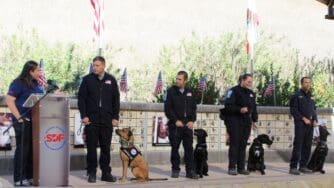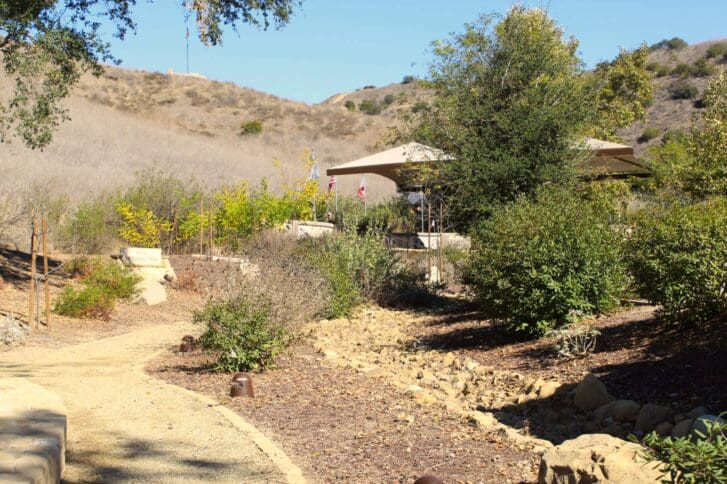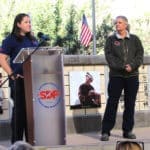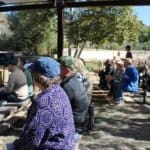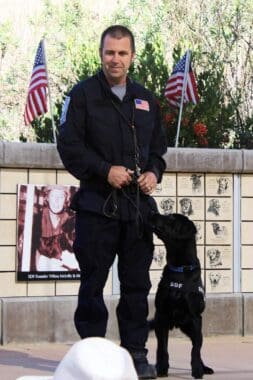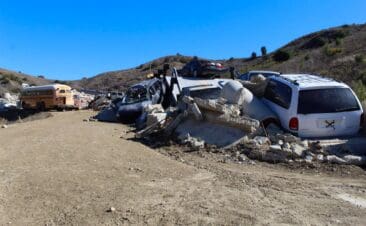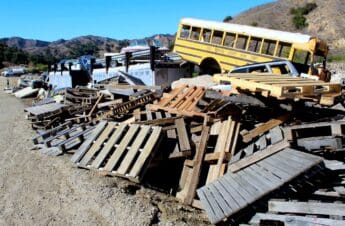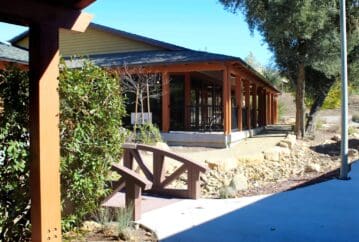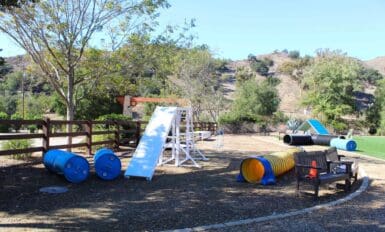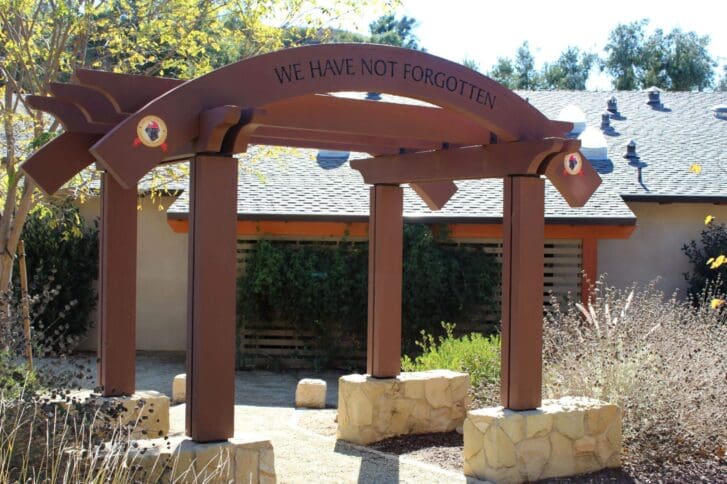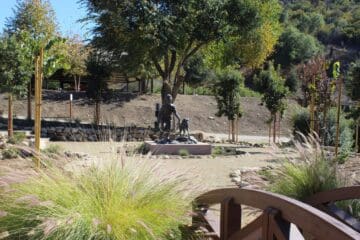Last weekend, I had the privilege of attending a Search Team Pairing Ceremony at the Search Dog Foundation’s (SDF) National Training Center, in Santa Paula, California. Communication Manager Estelle Webber invited me down to witness the pairing of Chirp, a Rescue Ranch dog, with handler Jeremy DeMott of the Chesapeake Fire Department, Virginia Task Force 2. I was so excited to go see one of our dogs come into his own.
It was going to be a long 10-hour drive according to Google and that didn’t include rest stops. My dog, Herbie, came along for the ride. He loves the car. We set out before daybreak on Friday morning and arrived at the motel in Camarillo about 12 hours later, just as the sun was setting. I didn’t know the area and was glad to have made it before nightfall.
The next day, we drove to the SDF National Training Center in the hills up behind Santa Paula. It was a beautiful drive. Herbie enjoyed it but would have to wait in the car at SDF. Estelle was there to greet me. We chatted and made our way to the small outdoor amphitheater in Memorial Park where the ceremony would take place.
An emotional Search Team Pairing Ceremony
A low wall lined with the portraits of all SDF graduates who have passed oserved as the backdrop for the stage. I found Vader, our first SDF graduate who saddly lost his battle with cancer died last February.
We took up places at the back and watched as the seats filled with family, friends, and colleagues. It was heartwarming to see that several superior officers were on hand to support their teams.
Senior Director of Communications & Search Team Operations Denise Sanders and Director of Canine Behavior and Training Mandy Tisdale, spoke in glowing terms about the dogs and their handlers.
Four teams were formally paired that Saturday morning. Three from Virginia Task force 2: Jeremy DeMott & Chirp, Chris Cook & Ridge, Brandy Outlaw & Pluto. And one from the Los Angeles County Fire Department, California Task Force 2: Derek Moree & Roma. All of the handlers were full of gratitude and kind words for the SDF program and staff. There wasn’t a dry eye in the crowd.
Graduating from the SDF program and getting paired is no small feat. It takes courage, patience, endurance, and sensitivity to succeed. SDF trainees are first responders but many have never worked with a dog before. SDF carefully screens prospects and their families to ensure that everyone is on board.
It takes nine months to a year to train a dog and another eight months to train the human half of a team. Handler training takes place online and in person. During their on-site practical training, prospects get to interact with all of the dogs. Instructors observe their work and look for chemistry. In the end, it’s the dogs who choose their handlers.
SDF prioritizes recruitment among rescue dogs.
The very characteristics make a good SAR dog cause many rescues to wind up in shelters and on kill lists. They’re too much to handle for the average adopter: they’re ball obsessive, have “over-the-top” energy, and constantly need something to do.
Ridge, for example, was adopted several times before landing at SDF. Without the right guidance he was bored, “crazy,” and became a total escape artist. According to Estelle, however, once he was in his element, he “turned out to be an absolute star in search training, and one of the few dogs who’ve had trainers’ jaws on the floor from day one.”
I noticed that, besides Chirp, the dogs that day were black. Including the two veterans who participated in the demo. Black dogs are notoriously hard to place at the best of times. Combined with the high intensity personality of a working dog, a black rescue hardly stands a chance at all.
Thank goodness, Chirp and the three others got lucky. They were selected for training at SDF where they found their purpose. Now they have a secure place in this world and the warmth of a family who loves them.
After going home, the teams will continue their training to pass FEMA certification. They’ll periodically retrain and recertify throughout their career.
After the ceremony, we were treated to a search demo by all four teams. They were tasked with finding a person hidden in the debris. It was fascinating to watch. Chirp (shown below) lived up to his name with his signature alert, which departs from the traditional bark of most dogs. Watch him in action in this video.
Two veteran teams from the Virgina Tesk force 2 joined the demo: Shawn Hall & Manion and Karen Meadows & Jax. Both recently deployed to Hurricane Ian.
A tour of SDF National Training Center
Afterward, Estelle took me on a tour. The property has two large rubble simulation training grounds. One is mostly a very large pile of variosly shaped cement rubble. Farther up the hill there’s a simulated highway collapse, complete with vehicles and a train wreck with real train cars.
The facility also includes classrooms, kennels, an onsite clinic, a covered agility course, and even a simulated town, aka “Search City.”
A large administrative building and a nice lodge for up to 20 trainees, are located between the show grounds and the amphitheater.
We passed by a statue of SDF founder Wilma Melville and her dog. Estelle explained that it was when Wilma was deployed to the Oklahoma Bombing , that she realized there just weren’t enough search teams in America to deal with large scale disasters. That’s when she established SDF.
I’m grateful for having been given the opportunity to visit the Training Center and to meet some of the wonderful people who make it possible. Thanks to SDF, a promising future awaits Chirp and many other dogs like him.
